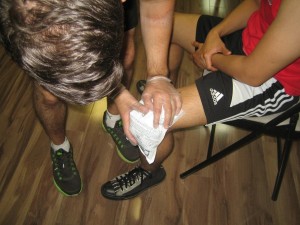Patellar tendonitis is best described as the inflammation of the patellar tendon. This tendon is responsible for attaching the quadriceps muscle to the tibia. Patellar tendonitis can develop due to an injury, aging or overuse. The individual will notice the pain beneath or behind the kneecap when standing or walking. Additionally, there is also swelling along the affected tendon. Always remember that this condition can be treated with conservative measures and basic first aid. On the other hand, if the tendon is ruptured, it would require surgery.
Rest
Always remember that the inflammation in the patellar tendon typically subsides once the individual rests. With this in mind, instruct the individual to rest. An individual with patellar tendonitis should avoid bending the knee excessively especially when squatting. Additionally, the individual must avoid performing lower body resistance training as well as jogging or running. Once the pain diminishes after a few days, the individual can engage in light exercise but he/she must not overdo it.
Application of ice

The application of ice is considered as an effective way to reduce the inflammation, swelling and pain along the patellar tendon. Once an ice pack is applied, it will shrink the blood vessels in order to reduce the amount of fluid that can accumulate. Applying ice will also numb the affected area and reduce the pain.
All you have to do is to apply an ice pack or frozen vegetable on the affected tendon for about 20 minutes. The ice must be removed for 20 minutes. The cycle must be repeated as often as possible within the initial three days of onset of the patellar tendonitis.
Medications
Over-the-counter pain medications and non-steroidal anti-inflammatory drugs (NSAIDs) can be given to treat patellar tendonitis. In most cases, NSAIDs are the preferred choice since they can minimize the inflammation in the tendon. The medications must be used as directed since they can cause detrimental side effects or damage the kidneys or liver.
If a doctor is consulted, a corticosteroid injection administered into the knee can help relieve the symptoms. This procedure is considered effective since the corticosteroid will reduce the inflammation around the patellar tendon. The pain tends to vary based on the tolerance level of the individual. Take note that there is a slight risk for infection. These injections can be performed every three months since they can cause harm to the knee joint if overused.
Physical therapy
A physical therapist will provide the individual with exercise that can be performed at home to treat the condition. Always remember that physical therapy can be effective as long as they are properly performed. After a set of exercises have been completed, an ice pack must be applied on the patellar tendon to prevent inflammation or swelling from occurring.
Surgical intervention
Surgery is rarely required for patellar tendonitis, but it is required if the patellar tendon is ruptured or torn. There is a risk for infection, chronic pain and nerve damage if patellar tendon repair is carried out. With this in mind, the individual must discuss with the doctor.
